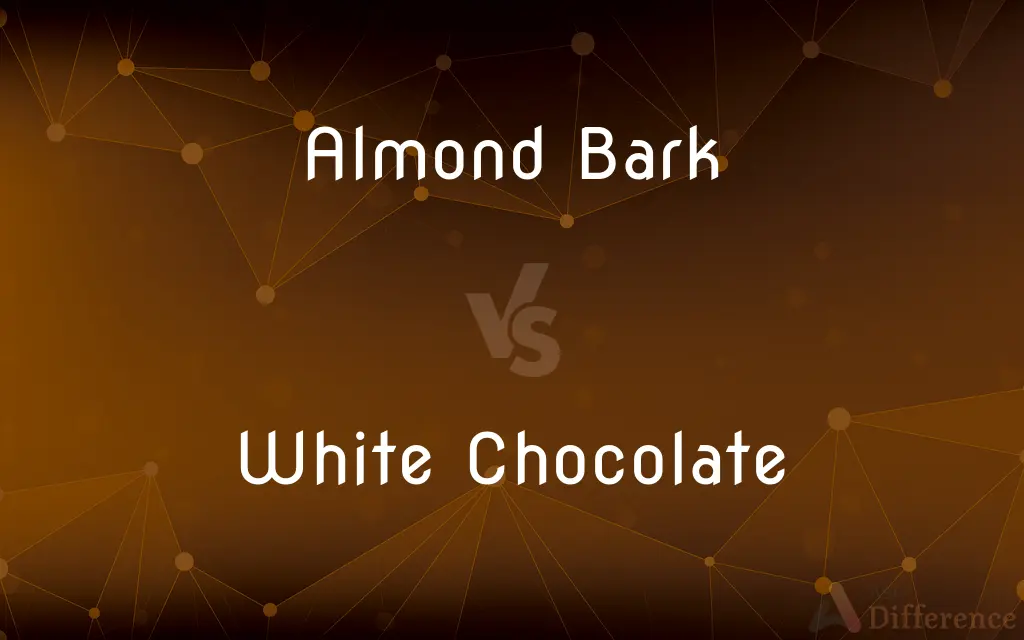Almond Bark vs. White Chocolate — What's the Difference?
By Urooj Arif & Fiza Rafique — Published on August 29, 2024
Almond bark is a confectionery coating made with vegetable fats, used for dipping and molding, without cocoa butter. White chocolate contains cocoa butter, sugar, and milk solids, offering a creamy texture and cocoa flavor.

Difference Between Almond Bark and White Chocolate
Table of Contents
ADVERTISEMENT
Key Differences
Almond bark is designed primarily for melting and coating; it's a versatile confectionery product that comes in vanilla and chocolate flavors, but notably does not contain cocoa butter. On the other hand, white chocolate is a type of chocolate that must contain at least 20% cocoa butter, along with sugar and milk solids, according to FDA regulations.
The melting point of almond bark is generally lower than that of white chocolate, owing to its vegetable fat content. This makes almond bark easier to work with for home cooks and professionals alike when it comes to coating or dipping. White chocolate, with its higher cocoa butter content, requires careful tempering to achieve a smooth, glossy finish when melted. Tempering white chocolate prevents it from becoming grainy or separating.
In terms of flavor, almond bark is sweet with a neutral taste, making it a good base for adding flavors or colors. It's often used in recipes where the main goal is a decorative or structural element rather than a rich flavor. White chocolate, however, offers a creamy, buttery taste with a hint of cocoa, making it a preferred choice for those seeking a luxurious taste experience in their desserts or confections.
Almond bark's affordability and ease of use make it a go-to option for bulk confectionery tasks, such as holiday candy making, where cost and convenience are key considerations. White chocolate, being a true chocolate product, is often more expensive and favored for its quality and taste in gourmet cooking and baking.
While almond bark can be a practical substitute for white chocolate in some applications, it cannot fully replicate the taste and mouthfeel of real white chocolate. This distinction is crucial for purists and those with a refined palate, who may prefer the authentic flavor profile that only cocoa butter can provide in white chocolate.
ADVERTISEMENT
Comparison Chart
Ingredients
Vegetable fats, sugar, milk solids (optional)
Cocoa butter, sugar, milk solids
Cocoa Butter
Absent
Present (at least 20% by FDA standards)
Use
Melting and coating
Eating as is, melting for confections
Flavor
Sweet, neutral
Creamy, buttery with a hint of cocoa
Melting Point
Lower, melts easily without tempering
Higher, requires tempering
Cost
Generally cheaper
More expensive due to cocoa butter content
Texture
Sets quickly, smooth
Creamy, rich
Regulatory Standards
Not classified as chocolate
Must meet specific FDA standards
Compare with Definitions
Almond Bark
Almond bark sets quickly without the need for tempering.
The almond bark set rapidly on the strawberries, speeding up the preparation.
White Chocolate
White chocolate contains cocoa butter, providing a creamy texture.
The white chocolate's cocoa butter gave the dessert a luxurious feel.
Almond Bark
Almond bark is an economical option for bulk confections.
For the holiday candy-making session, almond bark was a cost-effective choice.
White Chocolate
White chocolate pairs well with a variety of flavors, enhancing recipes.
White chocolate was used to elevate the flavor profile of the raspberry tart.
Almond Bark
Almond bark is a vegetable oil-based coating used for candy making.
She used melted almond bark for a quick setting on her homemade truffles.
White Chocolate
White chocolate requires tempering to achieve a glossy finish.
Tempering the white chocolate ensured a smooth coating for the cake.
Almond Bark
Almond bark is versatile in confectionery for its neutral taste.
Almond bark was chosen for its ability to blend well with various flavors.
White Chocolate
White chocolate is used in premium confections for its rich flavor.
He chose white chocolate for the ganache to add a depth of flavor.
Almond Bark
Almond bark melts smoothly, ideal for dipping and decorating.
Almond bark's easy melt made it perfect for coating the pretzels.
White Chocolate
White chocolate is defined by the FDA to contain at least 20% cocoa butter.
The high cocoa butter content qualified it as true white chocolate.
Common Curiosities
What is almond bark?
Almond bark is a confectionery coating made primarily of vegetable fats, designed for melting and coating sweets.
What distinguishes white chocolate from almond bark?
White chocolate contains cocoa butter, sugar, and milk solids, offering a creamy texture and flavor, unlike almond bark which lacks cocoa butter.
Is white chocolate considered real chocolate?
Yes, white chocolate is considered real chocolate but must contain at least 20% cocoa butter, according to FDA standards.
Is white chocolate healthier than almond bark?
Health considerations depend on the specific ingredients and quantities consumed; white chocolate contains cocoa butter, a saturated fat, while almond bark contains vegetable fats.
Can I make almond bark at home?
Yes, homemade almond bark can be made using a mixture of vegetable fats and flavorings, but replicating the exact commercial consistency might be challenging.
Can almond bark be used in place of white chocolate?
While almond bark can substitute white chocolate for coating purposes, it cannot replicate white chocolate's creamy texture and flavor.
Why is almond bark easier to work with than white chocolate?
Almond bark has a lower melting point and doesn't require tempering, making it easier to work with for coating and decorating.
What are the main uses of almond bark?
Almond bark is primarily used for dipping, coating, and decorative purposes in confectionery and baking.
Does almond bark contain nuts?
Despite its name, almond bark does not necessarily contain almonds or any nuts, referring instead to its use in almond-covered treats.
Does almond bark taste like chocolate?
Almond bark has a sweet, somewhat neutral flavor, lacking the cocoa flavor found in white chocolate due to the absence of cocoa butter.
Why does white chocolate need to be tempered?
White chocolate requires tempering to stabilize the cocoa butter, ensuring a smooth, glossy finish and preventing separation.
What is the price difference between almond bark and white chocolate?
Almond bark is generally cheaper than white chocolate, which is priced higher due to its cocoa butter content.
How do I choose between almond bark and white chocolate for a recipe?
Choose based on the desired outcome: almond bark for ease and convenience in coating, white chocolate for flavor and texture in eating quality confections.
Can white chocolate be melted without tempering?
While it can be melted, white chocolate without tempering may not set properly or have the desired texture and sheen.
Are there any dietary considerations when choosing between almond bark and white chocolate?
Dietary considerations include allergies to dairy or soy, present in both but in different forms, and preferences regarding vegetable fats versus cocoa butter.
Share Your Discovery

Previous Comparison
Cation Exchange Capacity vs. Anion Exchange Capacity
Next Comparison
Gypsies vs. TravellersAuthor Spotlight
Written by
Urooj ArifUrooj is a skilled content writer at Ask Difference, known for her exceptional ability to simplify complex topics into engaging and informative content. With a passion for research and a flair for clear, concise writing, she consistently delivers articles that resonate with our diverse audience.
Co-written by
Fiza RafiqueFiza Rafique is a skilled content writer at AskDifference.com, where she meticulously refines and enhances written pieces. Drawing from her vast editorial expertise, Fiza ensures clarity, accuracy, and precision in every article. Passionate about language, she continually seeks to elevate the quality of content for readers worldwide.













































